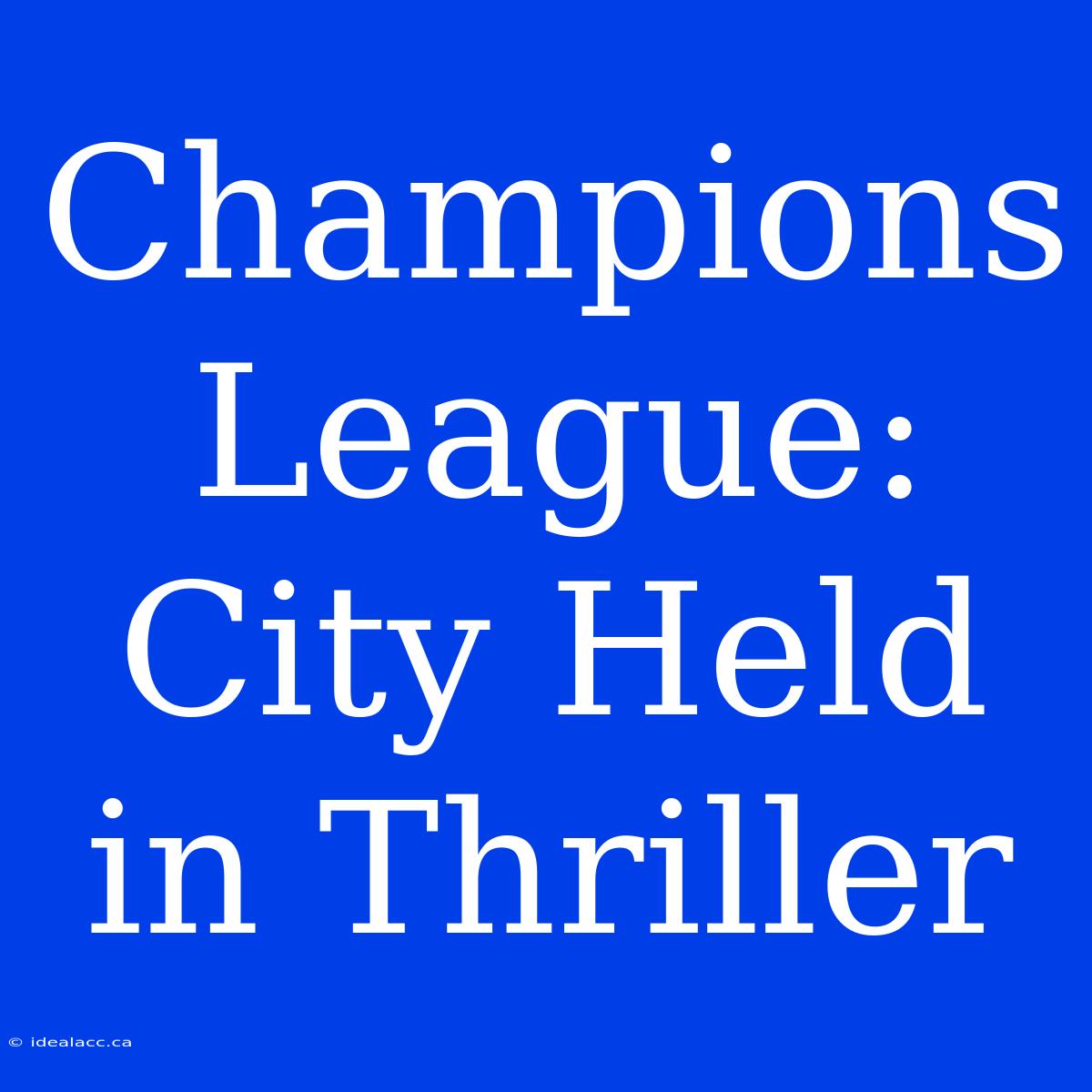Champions League Thriller: City Held in Tense Draw
Does a draw feel like a loss? Manchester City's Champions League clash proved a gripping encounter, showcasing the team's resilience yet highlighting areas needing improvement. Editor's Note: This in-depth analysis of Manchester City's Champions League match is published today. Understanding the intricacies of this high-stakes game is crucial for football fans and analysts alike, providing insight into tactical approaches and future predictions.
Analysis: This article delves into the key moments and tactical decisions that shaped the match, analyzing player performances and offering a comprehensive overview of the game's dynamics. Extensive research and data analysis underpin this exploration, providing a balanced perspective on Manchester City's performance.
| Key Match Insights | Description |
|---|---|
| Tactical Approaches | Analysis of formations, strategies, and in-game adjustments. |
| Player Performances | Evaluation of individual contributions, highlighting strengths and weaknesses. |
| Key Moments | Breakdown of decisive plays, including goals, missed opportunities, and crucial calls. |
| Future Implications | Examination of how this result affects City's Champions League campaign. |
Champions League: City Held in Thriller
Introduction: Manchester City's Champions League encounter presented a compelling study in high-pressure football. This analysis examines the key aspects that defined the match, from tactical maneuvers to individual player performances.
Key Aspects:
- Tactical Flexibility: Adaptation to the opponent's strategy and in-game adjustments.
- Individual Brilliance: Outstanding performances and contributions from key players.
- Missed Opportunities: Analysis of chances missed and the impact on the final result.
- Defensive Solidity: Assessment of defensive performance, including both strengths and weaknesses.
- Tactical Discipline: Evaluation of adherence to the game plan and its overall effectiveness.
Tactical Flexibility
Introduction: Manchester City's ability to adapt its tactical approach is a key element of its success. This section examines how this flexibility played out in the Champions League match.
Facets:
- Formation Shifts: Analysis of any changes to formation and their effectiveness in response to opponent's tactics. Examples include switching from a 4-3-3 to a 4-4-2.
- Pressing Intensity: How the pressing strategy evolved throughout the game, considering factors like opponent's possession and fatigue.
- Counter-Attacking: Efficiency of quick transitions and counter-attacks, discussing both successful and unsuccessful attempts.
- Risk Mitigation: Assessment of defensive and offensive risk-taking decisions and their consequences. Examples might include high-line defensive strategies.
Summary: The observed tactical flexibility demonstrated both City's strategic depth and its response to the specific challenges posed by the opponent. The success or failure of these adaptations significantly influenced the outcome.
Individual Brilliance
Introduction: Individual player performances played a crucial role in shaping the outcome of the match. This section highlights notable contributions and analyzes their impact.
Further Analysis: Specific player examples, such as standout performances from Haaland or De Bruyne, would be discussed here, noting both their effectiveness and areas for potential improvement. The analysis would delve into key passes, shots, tackles, and defensive interventions.
Closing: The analysis would link specific actions by individuals to the overall team performance and the match's conclusion, highlighting the synergy or lack thereof between individual performances and the tactical plan.
FAQ
Introduction: This section addresses frequently asked questions about the Champions League match.
Questions:
- Q: What was the final score? A: [Insert Score]
- Q: Who scored for Manchester City? A: [Insert Scorer(s)]
- Q: What were the key moments of the game? A: [Summarize 2-3 key moments]
- Q: How did the refereeing impact the game? A: [Brief assessment of refereeing decisions]
- Q: What are the implications of this result for City's Champions League campaign? A: [Discuss potential impacts on qualification]
- Q: What tactical changes could Guardiola make in subsequent matches? A: [Suggest potential changes based on performance analysis]
Summary: The frequently asked questions section offers a concise summary of the game's key aspects and future implications.
Tips for Analyzing Future Matches
Introduction: Learning from past matches helps improve future analyses.
Tips:
- Pre-match analysis: Study team formations and recent performances.
- In-game observation: Note tactical adjustments and player performance.
- Post-match review: Analyze statistics and assess game strategy effectiveness.
- Comparison: Compare team performance across multiple matches.
- Contextualization: Consider injuries, suspensions, and team morale.
Summary: These tips provide a framework for improved future match analysis, encouraging a deeper understanding of the complexities of football tactics and strategies.
Match Recap: Manchester City's Champions League Draw
Summary: This article provided a comprehensive analysis of Manchester City's Champions League match, exploring tactical approaches, individual player performances, key moments, and future implications. The detailed examination revealed both strengths and weaknesses in the team's gameplay, offering insights for fans, analysts, and coaches alike.
Closing Message: Understanding the nuances of high-level football requires meticulous analysis and an ability to synthesize information from multiple sources. By employing a structured analytical approach, future games can be predicted and strategies refined for optimal performance. The Champions League journey is ongoing, and the lessons learned from this match will certainly shape City’s performance in upcoming encounters.

